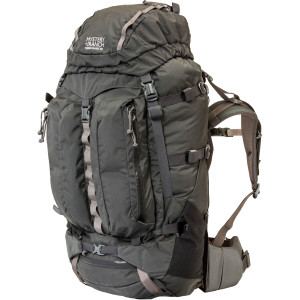Backpacking Backpacks
According to Wikipedia backpacking backpacks also called book bag, knapsack, rucksack, rucksack, pack, sack pack or back sack—is, in its simplest frameless form, a cloth sack carried on one’s back and secured with two straps that go over the shoulders, but it can have an external frame, internal frame, and there are bodypacks.
Backpacking backpacks are commonly used by hikers and students and are often preferred to handbags for carrying heavy loads or carrying any sort of equipment, because of the limited capacity to carry heavy weights for long periods of time in the hands.
Large backpacking backpacks, used to carry loads over 10 kilograms (22 lb), as well as smaller sports backpacks (e.g. running, cycling, hiking and hydration), usually offload the largest part (up to about 90%) of their weight onto padded hip belts, leaving the shoulder straps mainly for stabilising the load. This improves the potential to carry heavy loads, as the hips are stronger than the shoulders, and also increases agility and balance, since the load rides nearer the wearer’s own centre of mass.
Types of backpacking backpacks
Kelty Redwing 32 backpacking Backpack
The Redwing 32 is a smaller version of one of Kelty’s best-selling hiking packs, yet despite its relatively small size, it retains the quality of the original larger pack. That includes padding for your lumbar region and shoulders, ventilation mesh covering the shoulder and waist straps, and multiple pockets (including a pair for water bottles). With a 32-liter capacity, it could absolutely be an overnight or weekend pack if you didn’t need to bring a tent or sleeping bag, but the best way to use it is as a day pack loaded with all the gear, snacks, and backup apparel you need to have a great all-day outing that ends back in civilization.
Osprey Packs Porter 46L backpacking Backpacks
The shoulder straps and hip belt on the Osprey Porter 46 create the adjustable ergonomic support you need to carry plenty of weight for hours — it’s just what you might need on light woodland trails or camping trips. Unlike the other hiking backpacking backpacks on this list, it’s carry-on friendly, which makes it one of the few hiking backpacks that’s suitable for “trekking” through urban environments.
Klymit Motion 60 backpacking Backpacks
When you’re camping and carrying your air mat, sleeping bag, tent, stove, layers, food, first-aid kit, lighting, and so forth — your load adds up fast, even for two-night treks. That’s why for weekend treks backpackers can use the Klymit 60-liter capacity backpacking backpack. The straps are supportive, the materials water-resistant, and the pack keeps the weight near your centre of gravity, making long hikes easier. The best part of all is that you can adjust the pressure in the frame (which can help balance differences in weight in different parts of the backpack) by using a built-in hand pump. It changes everything.
Wilderness Backpackers
Wilderness Backpackers have sleeping arrangements which are usually communal with a dormitory-style arrangement consisting of beds or bunks, although private rooms are quite common. Wilderness Backpackers are a budget-friendly and cheap way of travelling in Wilderness. Staying at backpackers in Wilderness is often a preferred option for student travellers and the young-at-heart looking to meet up with fellow travellers.
Wilderness Backpackers will normally offer limited self-catering cooking facilities and social areas where everyone is welcome to get together. Areas and amenities such as showers, toilets, lounge and dining facilities will all be shared. Wi-Fi is usually a must-have for a wilderness backpacker. Wilderness backpacking is a form of self-reliant travel that affords opportunities to see sights available no other way.
What wilderness backpackers should know?
Carrying everything you’ll need to survive for several days in the wilderness isn’t everyone’s idea of a “vacation”, but if you don’t mind including some physical effort and additional inconvenience in your travel time, it’s an ideal way to truly “get away from it all”, and hopefully see some truly majestic scenery.
Landscape
Before taking off on a wilderness backpacking trip, assess what kind of territory you’ll be traveling through. Distances on a map never look that hard to cover, but once you find yourself staring up at a 400-foot ridge standing between you and tonight’s camp, it’s a different story. Topographic maps will give you a better idea of what you’re getting yourself into, as well as being essential for navigation if you’re going off-trail. Unless you have an uncanny sense of direction, you’ll probably need a compass. GPS can be nifty, but many feel it takes the adventure out of hiking, and it may not always work as well in actual use as the sales pitch suggests.
Climate
Find out what kind of weather you can expect at the time of year you’re planning to go. When’s the rainy season? What’s the temperature range? Keep in mind that going up in altitude is like going up in latitude. Daytime temperatures may be pleasant, but how cold does it get at night?
The wilderness is all about survival.
If as a wilderness backpacker you choose to go into the wilderness with nothing but the clothes on your back, you will need to carry a survival mind-set to find food, shelter and water to stay alive. Most of wilderness backpackers go to the wilderness for other reasons, though: adventure, tranquillity, to work their bodies, camaraderie, to observe wildlife and to enjoy the natural world.
Before you go, learn how to set up your shelter and use your stove and water purification system. Those are your survival tools. And then relax as you tune in to nature’s rhythms and rules. There’s no need to conquer anything. As most of wilderness backpackers spend time in wild places, they seem more and more tame.

